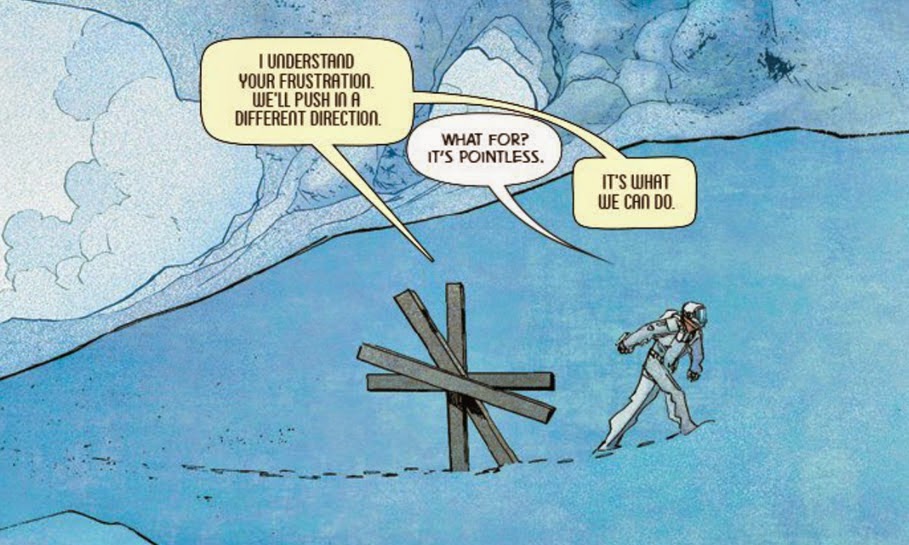A Boy And His Robot
I know the idea of having a faithful robot sidekick is very compelling. AT least, I assume the robot is the sidekick. Perhaps the human is the sidekick. The robot could lead from behind, as it were, and right now be fixing to plant a locomotive extremity upside the spaceman's backside.
Consider, if you will, the case of Ai Wei Wei of China.
In Medium we read:
Ai Weiwei is Living in Our Future
Living under permanent surveillance and what that means for our freedom
https://medium.com/@hansdezwart/ai-weiwei-is-living-in-our-future-474e5dd15e4f
... Ai Weiwei is very outspoken about the Chinese government and its freedom limiting policies. On April 3rd 2011 the Chinese government had enough and arrested him on trumped up charges of tax evasion.and the story goes on to speak of other techniques to follow pets and children and to make our lives - thank Ford! - all around better.
For more than 65 days he was locked in a small cell with two guards from the People’s Liberation Army watching him 24/7 from up close. They even stayed on his side when he showered or went to the toilet...
... After 81 days of staying in a cell he was released and could return to his home and studio in Beijing. His freedom was very limited: they took away his passport, put him under house arrest, forbid him to talk with journalists about his arrest, forced him to stop using social media and put up camera’s all around his house...
... At some point, for example, he decided to put up four cameras inside his house and livestream his life to the Internet. This made the authorities very nervous and within a few days the ‘WeiWeiCam’ was taken offline.
Close to his house there is a parking lot where Ai Weiwei regularly catches some fresh air and walks in circles to stay in shape. He knows he is being watched and is constantly on the lookout for the people watching him. In a very funny scene he sees two undercover policemen observing him from a terrace on the first floor of a restaurant. He rushes into the restaurant and climbs the stairs. He stands next to the table that seats the agents, who at this point try and hide their tele-lensed cameras and look very uncomfortable. Ai Weiwei turns to the camera and says: “If you had to keep a watch on me, wouldn’t this be the ideal spot?”
This scene shows how being responsible for watching somebody isn’t a pleasant job at all. The young boys that had to guard Ai Weiwei in his cell had to stand completely still, weren’t allowed to talk and couldn’t even blink their eyes. According to Ai Weiwei their bones made cracking noises when they were finally allowed to move again at the end of their shift. This obviously is an inhumane practice and I wasn’t surprised to learn that these boys, even though there were cameras everywhere, still found a way to communicate with Ai Weiwei and regain some of their humanity. During the few moments that there was some movement in the cell, like when walking to the shower, they asked him questions with their lips tightly closed. Just like ventriloquists...
Then in Slate there is this from Hitachi:
Public Safety for Smart Cities
A collaborative, organized system of technologies can help prevent and suppress crime.
By Mark S. Jules
Cities around the world are becoming smarter and more connected. It’s projected that by 2020, 50 billion smart physical objects – everything from oil rigs to refrigerators, cars, and medical devices - will be connected to each other and to humans, generating unprecedented amounts of data. Analyst firm IDC estimates that in the same timeframe, over 42% of all data will come from machines.
The ability to integrate and analyze these massive amounts of data in a way that enables businesses, governments, smart cities and others to anticipate, mitigate, and even prevent many problems they will face is key to delivering positive outcomes for society. Through its Social Innovation Business, Hitachi is working to make the world safer and more secure, by integrating IT and infrastructure technologies that drive business and social outcomes.
Consider the following example: A subway platform that has sensors embedded to monitor and flag overcrowding. As they sense the platform reaching capacity, the sensors automatically alert police and transportation officials, who take action by sending busses [sic] to the station as an extra means of transportation. They can head to the station themselves for crowd control, and even automatically reroute additional trains to accommodate demand. Now, imagine these same platforms have installed cameras with gunshot detection capabilities. The cameras sense a shooting on the platform. Video of the shooting is sent to police cruisers, along with a live feed from the subway platform. And if the attacker flees in his car, cameras from a nearby hotel capture his license plate number...
[...]
It’s also important that this data and visualization be accessible on any screen in any location, whether via smartphone, laptop, or a police cruiser terminal. Command-and-control centers are becoming a thing of the past; personnel need flexibility and universal data access to match the unpredictability of emergencies.
And, finally, it’s essential to have infrastructure that allows organizations to take action in one system based on data coming from another – for example, if a license plate recognition system indicates that a vehicle is stolen, it should automatically marshal nearby cameras to capture video of the driver. The best systems also enable collective action – in this same scenario, once the vehicle is identified, alerts should go out to all nearby police officers who then work together based on their shared information.
The best public safety systems will do each of these things – allow us to connect, analyze and view data from any device, and take coordinated action. By better enabling law enforcement and emergency personnel to collaborate, we give ourselves the opportunity to live in a safer, healthier, and more vibrant world.
A vibrant NSA world, perhaps.
And Walter Isaacson on AI in WIRED:
Walter Isaacson on The Imitation Game and Making Alan Turing Famous
By Geek's Guide to the Galaxy
01.03.15
http://www.wired.com/2015/01/geeks-guide-walter-isaacson/
Walter Isaacson
Walter Isaacson on artificial intelligence:
... “It always seems to be 20 years away. In fact, at the beginning of this year, if you just search it, you’ll find stories in the New York Times saying that neuromorphic chips are being developed that’ll mimic the human mind, and in 20 years we’ll have artificial intelligence. It always seems to be a bit of a mirage, and it always seems that things like Google or Wikipedia that combine human creativity with machine power always make greater advances than machine power alone does. … This is something that Gary Kasparov figures out when he gets beaten by the IBM machine Deep Blue. He decides to create a contest in which humans working with computers can play either the best computer or against the best human grand master. And in all of these contests, the combination of the human and machine—even if it’s amateur players working with laptop machines—tends to beat the grand master or the best computer. And this is a game—chess—which you have to remember is simply an algorithmic rule-driven game, so eventually computers should be able to crack that totally. On far more complicated things like ‘Should the NSA be allowed to eavesdrop?’ that’s a question I don’t think machines will ever be able to answer as well as a combination of machines and humans could.”
First, let us observe that the so-called progress toward AI (Artificial Intelligence) is paralleled by and probably being outstripped by a progress towards a Mechanization or Digitization of the Human Being into analyzable data.
We shall call this process which is a Looking-Glass to AI the AM project: Artificial Machine.
Second, it will be a good deal easier for machine to emulate humans if the humans were already somewhat rendered machine-like. Sort of like meeting Robby the Robot half-way.
We are dumbing people down faster than we are making machines intelligent. People will become panopticon observable data equivalent to rudimentary machines; machine will not become people.
Thirdly, I do not believe the human mind works solely nor most importantly by digital codes. I further do not believe that digital codes can reproduce human intelligence in any worthwhile way, no matter how wondrous their algorithmic abilities are.
Referring back to Walter Isaacson, IBM's Deep Blue calculates. Deep Blue cannot "see" the answer in the unspoken, tacit, intuitive way that a human being often can. Humans cannot communicate with the speed of light, as machine can, but humans can hold a conversation for 50 years or more.
The flow of information is not necessarily slow, but it can be so infinitely detailed and complex that it takes a long, long time.
Imagine having a conversation for half a century!
We already do with friends and family. We experience the flow of detailed experiences which are beyond the codified languages of man and machine.
We can even comm. with the non-human.
I sometimes tell the story about how I used to run for 20 years on the same route down to Lake St. Clair and back, passing the same trees and plant and waters, birds, houses, etc. over and over.
I began to know what short-term late autumn and early winter weather patterns would be (30 to 45 days). I called it "talking to the trees", although I never uttered a word to a tree or bush. Truth!
I told this story to a young lady once, who was a runner. She said, "Yeah. I know what you mean."
And I could tell she did.
--
pix at top of article:
Revealed: The Lost Chapter of Interstellar
By Christopher Nolan & Sean Gordon Murphy
11.18.14
http://www.wired.com/2014/11/absolute-zero/
























No comments:
Post a Comment